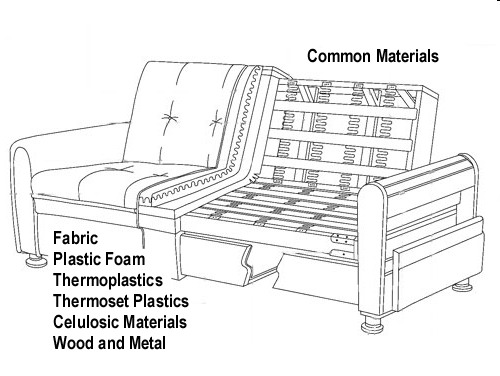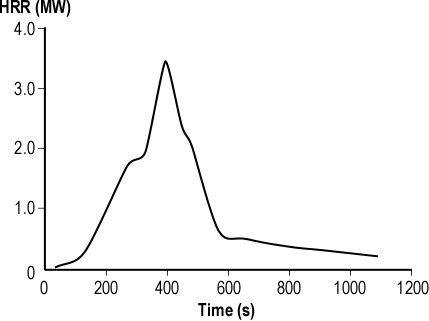Visualizing Fuel Packages
Monday, February 2nd, 2009As discussed in previous posts, fuel and ventilation are the major controlling factors in compartment fire development. Compartment fires begin with the ignition of a single item. If energy is released at a sufficient rate, the fire will extend to other fuel and begin to influence the compartment environment. A single burning item or object exposed to heat transfer resulting from a fire is referred to as a fuel package. Fuel packages can be comprised of a single fuel (e.g., wood, plastic) or they may be composites of a number of different materials (e.g., upholstered chair, sofa, or mattress). This post will examine a familiar fuel package often involved in residential fires, the ordinary sofa.
The Sofa as a Fuel Package
Upholstered furniture such as chairs, recliners, love seats and sofas are common fuel packages in the living room or family room of a residential occupancy. A single upholstered chair is likely to provide sufficient energy and heat release rate to take a 3.05 M x 3.66 M (10′ x 12′) room to flashover. A sofa on the other hand can provide three times the energy and heat release rate as a single chair.
Figure 1. Upholstered Furniture as a Composite Fuel Package

As illustrated in Figure 1, upholstered furniture such as a couch is a composite of a number of different materials, most of which are fuel. The frame is generally constructed of metal, wood or an engineered wood product such as plywood or particleboard. In older furniture, padding consisted of natural fiber materials, while modern furniture generally has some type of plastic foam padding. The upholstery can be natural fiber fabric or some type of synthetic material. Most of the synthetic materials used in furniture construction have more potential energy per unit mass (kg or lb) than wood or natural fiber padding and fabric.
Ignition Scenarios
Open flame, smoldering combustion (e.g., carelessly discarded cigarette), or hot objects (e.g., portable heater) can provide sufficient energy to ignite upholstered furniture. Smoldering combustion can progress slowly through layers of material, resulting in a large quantity of toxic and flammable products of incomplete combustion and may even self-extinguish. However, if smoldering combustion reaches the edge or surface, or if the initial ignition resulted in flaming combustion, the fire may transition rapidly from an incipient to growth stage fire.
Potential Heat Release Rate
Given an adequate supply of oxygen heat release rate is dependent on fuel type(s) and geometry. For example, the heat release rate (HRR) from a burning sofa can quickly reach as high as 3 MW as illustrated in Figure 2. This is easily enough to result in extension to other fuel packages and result in rapid transition from the growth stage to a fully developed fire in the compartment (flashover).
Figure 2. HRR from a Couch

This HRR curve was adapted from National Institute for Standards and Technology (NIST) tests of fuel packages. Phographs, video, and detailed test data are available on the NIST Building Fire Laboratory web site.
Ventilation Controlled Burning Regime
In many cases, the developing compartment fire becomes ventilation controlled and HRR is diminished, failing to reach the peak illustrated in Figure 2. When the fire becomes ventilation controlled, fuel continues to pyrolize, transitioning from solid to gas phase fuel in the smoke layer. If the compartment is tightly sealed, the fire may self-extinguish. However, an increase in ventilation (e.g., failure of a window or opening a door to gain access for firefighting operations) can result in a rapid increase in heat release rate, and potentially a transition to a fully developed fire (ventilation induced flashover).
Things to Think About
This post examined a common piece of furniture found in most residential occupancies. Consider that there are many others and that fuel packages can also include interior finish such as carpet and structural materials. Wildland firefighters are well aware of the hazards presented by different fuel models, structural firefighters should consider the types of “fuel model” presented by different types and configurations of contents and structural materials in the built environment.
Ed Hartin, MS, EFO, MIFireE, CFO


